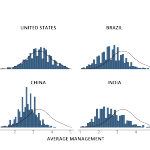 As the notion of core competencies has taken hold in the last few years there has been a growing appreciation that good management could be as beneficial to an organization as the latest technology. Quite what qualifies as good management however is still up for dispute, with much to suggest that it is largely contingent upon the particular circumstances one finds oneself in.
As the notion of core competencies has taken hold in the last few years there has been a growing appreciation that good management could be as beneficial to an organization as the latest technology. Quite what qualifies as good management however is still up for dispute, with much to suggest that it is largely contingent upon the particular circumstances one finds oneself in.
This makes identifying and spreading best practice difficult however, and overcoming this challenge was a central goal of a recent paper by Nicholas Bloom, John Van Reenen and Raffaella Sadun.
What does good management look like?
“The point for practitioners is that managerial processes are as important as other inputs in production and can create significant competitive advantage” they argue.
The researchers examined around 11,000 companies from around the world over a number of years to try and ascertain what kind of management was being practiced.
When the analysis was complete, there appeared to be a strong correlation between the management scores and the productivity of a country. Interestingly however, this variation was not confined to international metrics, with considerable variance within countries too.
For instance, within the United States there was a significant difference in the managerial abilities of the most productive firms versus laggards. This materialized in a 15% boost to productivity for firms in the top 25% of managerial capability over those firms in the bottom 25%.
When this was examined across the world, the researchers believe that the quality of management was accounting for around 30% of the variance in productivity.
Why management matters
There are a number of factors that seemed to support good management, not least of which was a high level of competition. What’s more, older companies seemed to score more highly than newer ones, which perhaps reflects the input management has on the sustainability of a company.
There were also connections between the management score and the skill levels of workers, with higher management capabilities linked with more highly skilled workforces.
“Stronger companies according to our score have people who make intensive use of data,” the researchers say. “These practices require a certain level of competency and numeracy in the workforce.”
This high skill requirement for deliverance of good management underlines why it is so challenging to share best practice. It isn’t like a light switch that can be turned on and in reality is a very complex change process that certainly offers no guarantees.
Making the change
The threat is not only to workers however, as greater democratization of information or diffusion of decision making can easily be perceived as a threat to managers traditional power base.
The paper also identifies the challenges inherent in overcoming the illusory superiority bias that tends to see most managers thinking that their management and processes are much better than they really are. Gaining that candid picture on the true state of affairs is often very challenging, but it’s something that the authors hope to facilitate by sharing their data on the project’s website.
In addition to providing benchmarking, the site also provides instructions on how organizations can survey their own strengths and weaknesses. With the benefits of good leadership now more readily apparent, hopefully the tool will go some way towards helping organizations up their game.